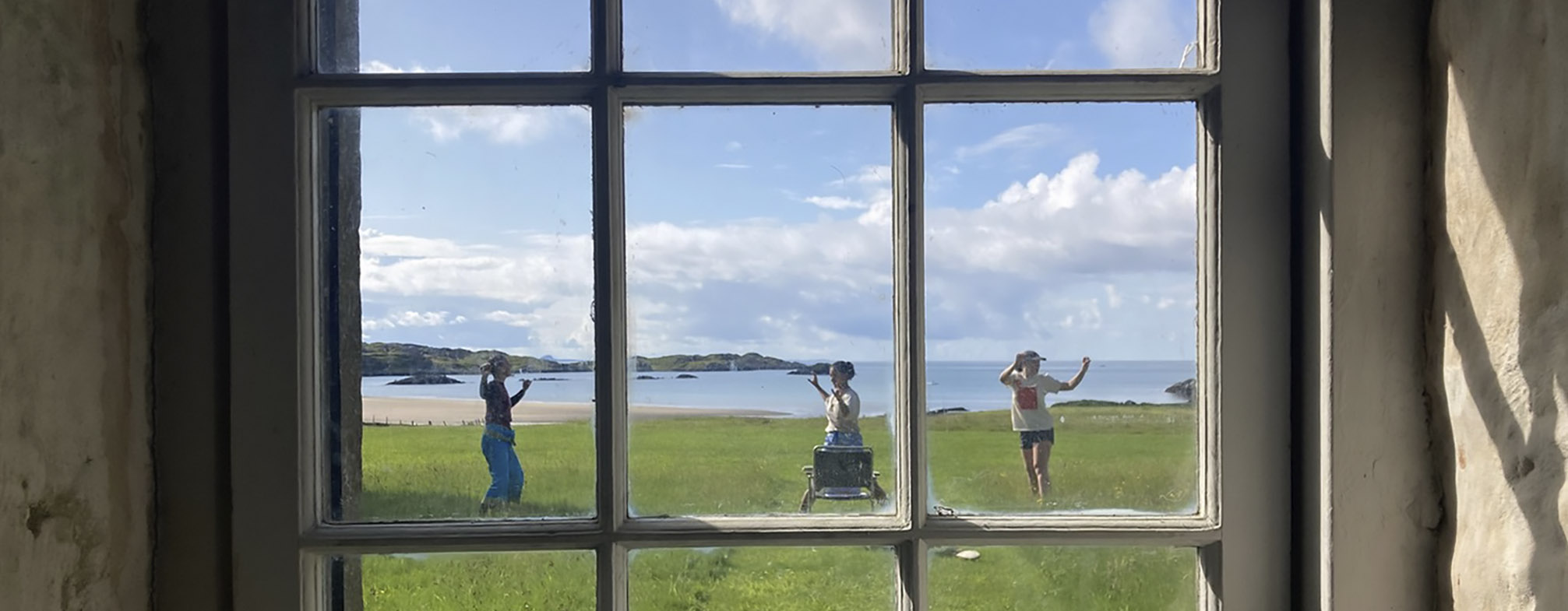
Breachacha Embrace Program 2025
This year program will focus on the minor gesture as described in Erin Manning’s book The Minor Gesture. Somehow Erin Manning’s minor gesture reminds us of The Book of Small by Emily Carr. Both women are Canadian and pioneering—pioneering, that is, the daily, the minor, the cast-aside, the invisible, yet in different times and ways.
As Manning writes: “The minor is a continual variation on experience. It has a mobility not given to the major: its rhythms are not controlled by a preexisting structure, but open to flux. In variation is in change, indeterminate. But indeterminacy, because of its wildness, is often seen as unrigorous, flimsy, its lack of solidity mistaken for a lack of consistency. The minor thus gets cast aside, overlooked, or forgotten in the interplay of major chords. This is the downside of the minor, but also its strength: that it does not have the full force of a preexisting status, of a given structure, of a predetermined metric, to keep it alive. It is out of time, untimely, rhythmically inventing its own pulse.
The minor isn’t known in advance. It never reproduces itself in its own image. Each minor gesture is singularly connected to the event at hand, immanent to the in-act. This makes it pragmatic. But the minor gesture also exceeds the bounds of the event, touching on the ineffable quality of its more-than. This makes it speculative. The minor gesture works in the mode of speculative pragmatism. From a speculatively pragmatic stance, it invents its own value, a value as ephemeral as it is mobile. This permeability tends to make it ungraspable, and often unrecognizable: it is no doubt difficult to value that which has little perceptible from, that which has not yet quite been invented, let alone defined. And so the minor gesture often goes by unperceived, its improvisational threads of variability overlooked, despite their being in our midst. There is no question that the minor is precarious.
And yet the minor gesture is everywhere, all the time. Despite its precarity, it resurfaces punctually, claiming not space as such, but space-of-variation. The minor invents new forms of existence, and with them, in them, we come to be. These temporary forms of life travel across the everyday, making untimely existing political structures, activating new modes of perception, inventing languages that speak in the interstices of major tongues.”
Summer Residencies: THE MINOR GESTURE
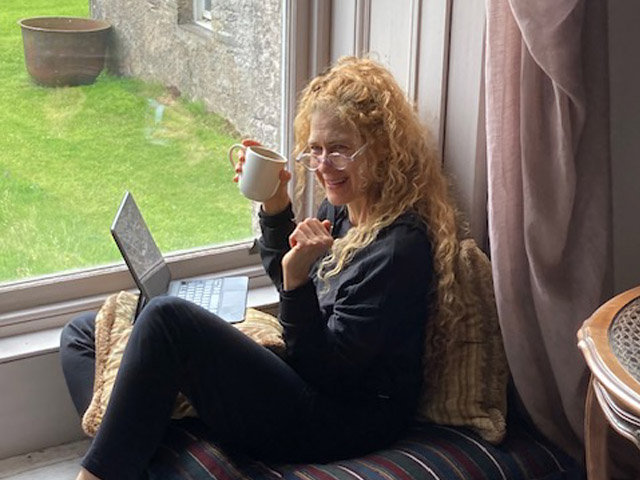
Erin Manning
– ERIN MANNING & BRIAN MASSUMI
Erin Manning works at the intersection of philosophy, aesthetics and politics, always with an interest in alter-pedagogical and alter-economic practices. Pedagogical experiments are central to her work, some of which take place at Concordia University in Montreal, where she holds the Chair in Speculative Pragmatism, Art and Pedagogy in the Faculty of Fine Arts. Her recent monographs include The Minor Gesture (Duke 2016), For a Pragmatics of the Useless (2020) and Out of the Clear (minor compositions 2022). Her art is based on textiles and is relationally oriented, often participatory. She is interested in the detail of material complexity, in what is revealed obliquely to perception, in the quality of a textural engagement with life.
The originality of Manning’s work often relies on the synesthetic with the haptic, the touch, most recently in recognition of and experimentation with the ProTactile movement for a DeafBlind culture and language. Tactile proposals include large-scale suspensions produced with a variety of tools such as tufting, crocheting, knotting and weaving. Her project 3e is the main direction of her current research—an exploration of the transversality of the three ecologies, the social, the environmental and the conceptual. An iteration of 3e is a project based on the land north of Montreal where living and learning is experimented with. The project is permeated by the results of her SenseLab, in particular the question of how collectivity is created in a more than human encounter with worlds in the making.
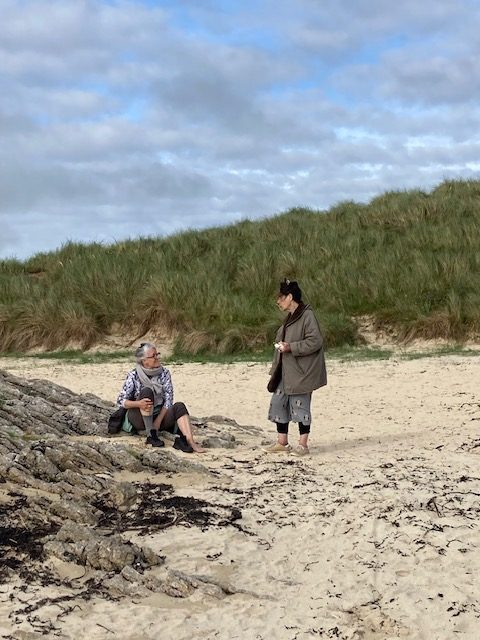
International curators Catherine David and Corinne Diserens
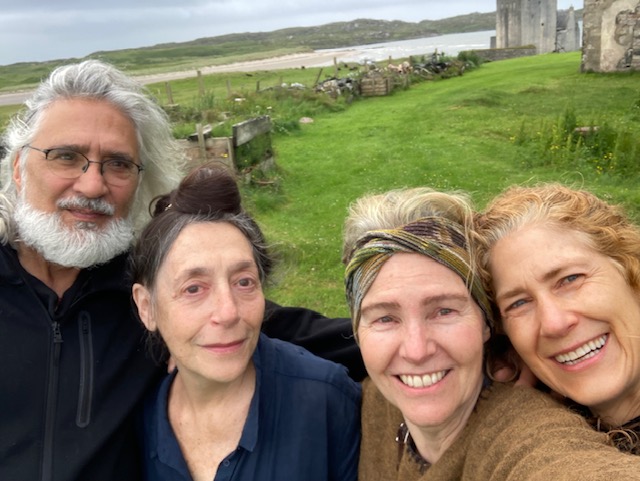
Brian Massumi, Catherine David, Catherine de Zegher and Erin Manning
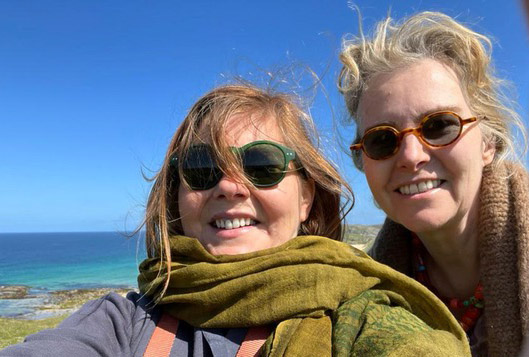
Emma Nicolson and Catherine de Zegher
Brian Massumi is a Canadian philosopher and social theorist. Massumi’s research spans the fields of art, architecture, cultural studies, political theory and philosophy. His work explores the intersection between power, perception, and creativity to develop an approach of thought and social action bridging the aesthetic and political domains.
His latest book is titled The Personality of Power and was published by Duke University Press this year.
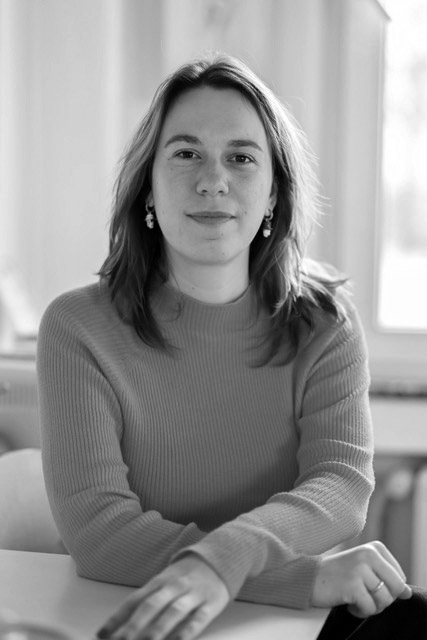
Yelena Schmitz
Yelena Schmitz is a promising new voice in children’s literature in Belgium. She is a writer, theatre and audio maker.
With ‘Hotel Kosmos’ she won the Fintro Literature Prize for Dutch Literature and was nominated for De Boon. A recognition for her ability to make major themes comprehensible and accessible for young readers. Every two weeks Schmitz surprises readers of ‘De Standaard’ with sharp and playful columns about our world.
“During my residency, I worked on my novel almost every morning. From a distance, in a place where there is plenty of time and space, you can think very clearly. It had been a long time since I had been able to write so much and so freely. I loved the desk by the window and watched almost every season pass by. I hadn’t expected to discover and collect so many new stories alongside my novel. The island is magical, and I met many residents: the man with the yellow boots, the beekeepers, the woman from the post office. I went on adventures: I swam with seals, collected seaweed and looked at the moon every night. I did tai chi on the beach and learned the first steps of capoeira, thanks to the other residents. Now I’m back home, with lots of new texts, new inspiration and an empty, fresh and cheerful head. I am very grateful for this time in Scotland.”
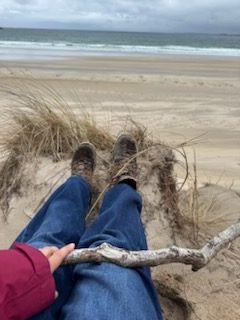

With support of FINTRO
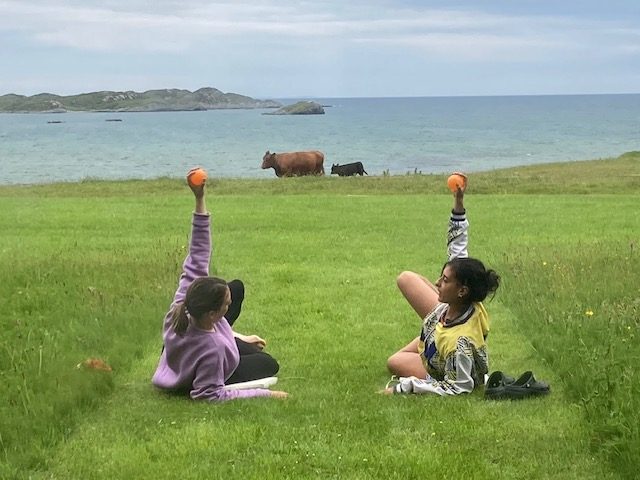
Dance classes with Marianna and Yelena
Marianna Syfridi & Elisa Israra gave a preview of their performance NOSTOS together on the first pier of the Isle of Coll
Marianna Sfyridi joins this year’s residency to expand on “NOSTOS: Migrating Bodies, Migrating Dances,” a multidisciplinary exploration of migration, identity, and embodied landscapes. Inspired by the fluid dynamic of the greek ritual of getting rid of the evil eye with “oil in water”— where separate entities coexist, shifting and reshaping one another — the project reflects on how personal and cultural histories migrate through the body.
As she writes: “Drawing from Capoeira, Greek traditional dance, and somatics, I explore how movement holds the memory of place and displacement. My Circadian Bodies Methodology, also weaves into this work, focusing on how human rhythms align with natural cycles — embodying the delicate, often unnoticed micro-adjustments that connect us to the ecosystems we inhabit. This connects to Erin Manning’s concept of The Minor Gesture, where small, subtle shifts hold the potential for radical transformation. I am curious to explore how the body’s quiet, adaptive gestures like the ones we use in our ancestors’ rituals— often overlooked — mirror the resilience and adaptability found in nature.”
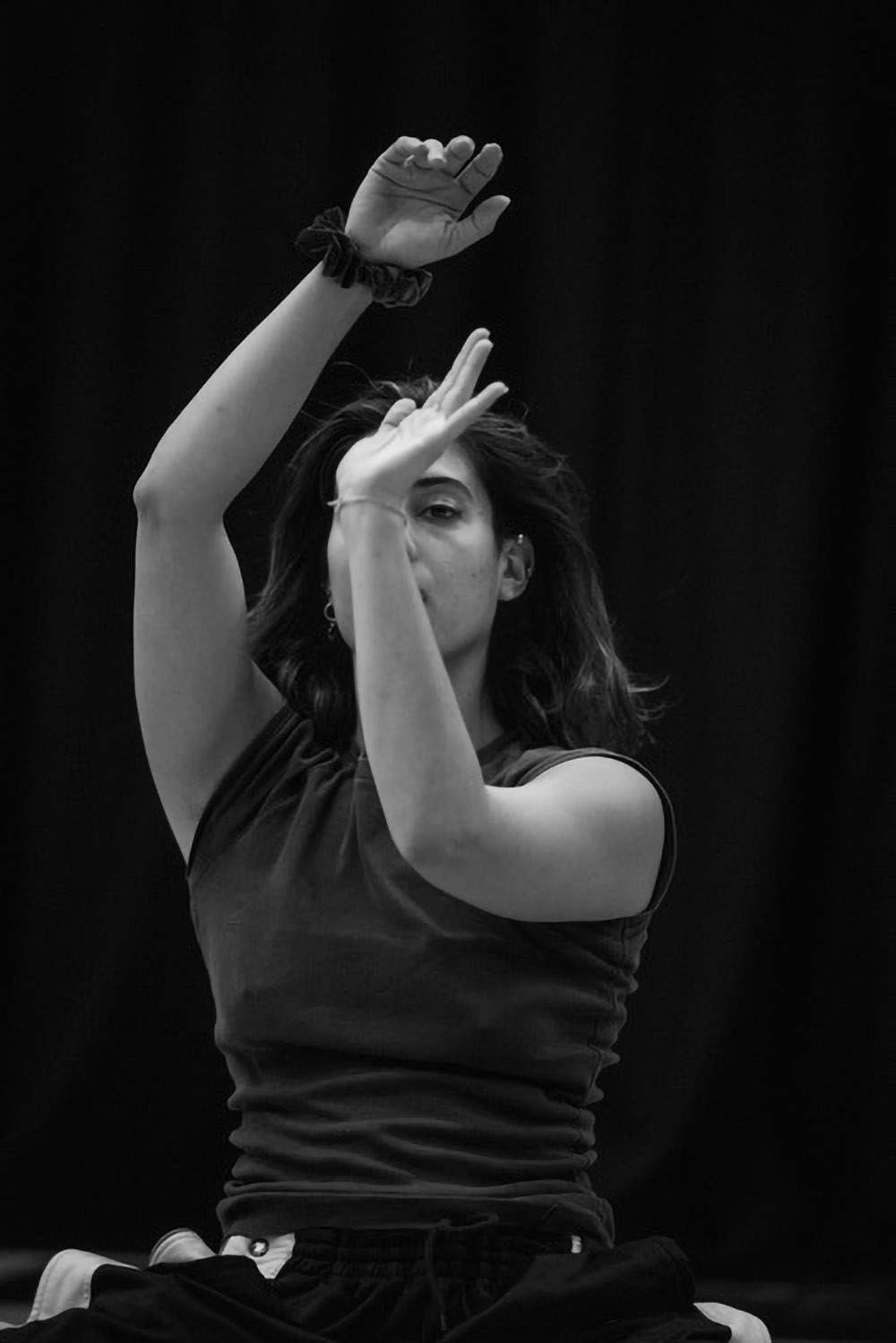
Marianna Sfyridi

Ritual of Swuš, Bhrahaspati Kund, Madhya Pradesh, India. 2025
Dominique Savitri Bonarjee is an Indian-French pluri-cultural artist. Her art practice centers aliveness, guided by the logic of water and fluidity. In her Art PhD at Goldsmiths University of London (2024), entitled ‘Space of the Nameless’, she develops somatic practices for polydisciplinary and collaborative ways of making art.
Dominique Bonarjee writes: “During my residency in Khajuraho, India, I was fascinated by the watery symbols carved into the temples. Each temple is covered its own multiplicity of swirling and swooshing shapes. These are not just decorative fillers but intricate and energetic depictions of water’s movement. In a new series of works Swuš, I explore this imagery in a speculative fiction about love and renewal after Collapse (also the name of my current series of works). During my residency at Embrace Space, I followed this viscous, languid Swuš * by embodying seaweed’s choreo-graphy in my daily life: deciphering by dancing. A dance in which I embrace the minor gesture in its fugitivity, imperceptibility, and attention to subtlety. There is a gentle resistance involved in being a ‘minor artist’. There is a slight tension that appears in the algae when they are moved by strong currents; their resistance is what makes them dance. In my practice it gives me time to not know and be comfortable with this. I would rather forget the creative/productive guilt of social media at these moments, and stay engaged, present and there for and with others in my immediate cosmology. Here my practice is swimming, walking, noticing the colours and changes –shrinking, discolouration, reanimation, disappearance– in the transitional bardo between land and sea, the intertidal zone. Sharing this knowing with others also, through dances of ‘dryland swimming’, combining Taoist tai chi chuan with the embodied poetics of unknowing self-hood. Also, through the conviviality of cooking and sharing food, caring for each other’s watery bodies. My days were given to attuning to the wind, singing to the rhythm of the ocean, wandering through cow pats on the vast beaches –even being initiated to bovine love trysts– and receiving magical bones of ancient water mammals whitened by the endless heaving of the tides.”
* Swuš is the guiding onomatopoeia in a new stage of my art practice that involves the creation of contemporary water rituals, votive objects, and a speculative fiction about water’s ancient knowing. Swuš is a ‘Sanskrit-ification’ of the word swoosh, which means ‘to move with or make a rushing sound, to swirl copiously, to cause to move with or make a rushing or swirling sound’.
Dominique Bonarjee